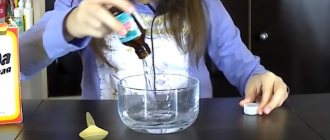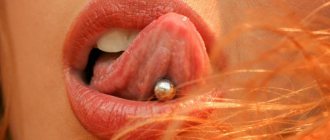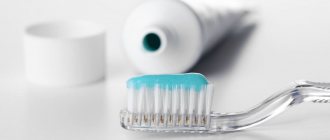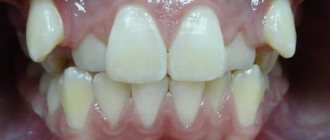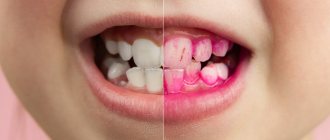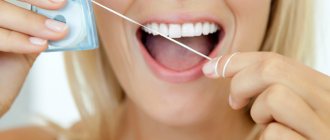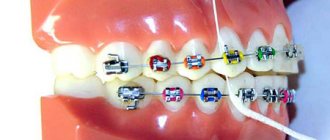Sodium Lauryl Sulfate (SLS) is a cheap petroleum product with a strong cleansing effect. Used for cleaning, foaming and dissolving fats.
You can look at the composition of all shampoos in your nearest supermarket. Approximately 100% of them will have sulfates in the list of ingredients, although cunning marketers will try to hide them under incomprehensible words. At the same time, expensive shampoos in specialized stores will be labeled “sulfate-free,” but is it necessary to overpay for this feature?
Remember how bad shampoos lathered in our childhood? But now the cheapest shampoo has excellent thick and persistent foam, which is so pleasant to wash off from your hair. All this thanks to the advent of SLS!
As you already know (from our previous article on parabens), not all “harmful” substances are actually harmful. Perhaps dangerous properties are attributed to the components by marketers who are looking for a way to sell you more expensive products. Let's figure out what's going on with this component?
Acure Organics makes shampoos free of parabens, sulfates and phthalates.
Physical characteristics and methods of production
Sodium laureth sulfate is an anionic surfactant used in the cosmetics industry since the mid-20th century. SLES is a powder with a density of 1.05 g/cm3. Its use in cosmetics is explained by the complete absence of a specific odor.
In addition, sodium laureth sulfate only spontaneously ignites at 310℃, making it suitable for use in the production of machine oils and industrial equipment. When decomposed, SLES does not become toxic and dissolves quickly in water.
Sodium laureth sulfate is a substance that is obtained by converting sodium lauryl sulfate, it is a milder analogue. The process of processing SLS into SLES uses alcohol from coconut oil. Therefore, it is sodium laureth sulfate that has a higher cost.
Laureth sulfate is prepared as follows:
- Lauryl alcohol reacts chemically with sulfur trioxide in the form of a gas.
- The resulting gas is neutralized with sodium hydroxide.
- Bleaching agents are added to change the color from yellow to clear.
Official opinion on the dangers of SLS
He's gone. In 1983, experts at The Cosmetic Ingredient Review decided that there was no harm from this component.
Over the next 30 years, many studies have been conducted on this substance, which have established possible harm to the body. The fact of accumulation of SLS in the body, drying of the skin, allergic reactions and everything else that we wrote about above was proven.
By the way, experiments on rats showed a real danger when high concentrations of SLS accumulate in the blood. Thus, 1.1 g/kg of the substance caused depression in rats, difficulty breathing and death in 4 out of 20 animals. The substance caused visual impairment in rabbits. At the same time, the use of low concentration SLS did not cause changes in the condition of the animals even with long-term use.
Operating principle
When in contact with hair or skin, SLES molecules penetrate between the dirt and the surface being cleaned. After foaming, the fat thickens and turns into small drops that are easy to wash off. However, due to the aggressive effects of sulfates, all protective substances are washed off from hair and skin along with dirt and grease.
Action of Sodium laureth sulfate
After washing, hair and skin are deprived of the necessary moisture, which leads to dryness and irritation. Shampoo should only cleanse the hair, and the sulfate, along with dirt, takes away water and the necessary layer of fat, which protects the hair and is a natural antistatic agent. In order to reduce the concentration of sulfates on your hair, after washing you can rinse it with a weak vinegar solution.
What is Sodium lauryl sulfate?
Sodium lauryl sulfate (or sodium laureth sulfate) is found in 98% of shampoos, shower gels and liquid soaps. This substance is hidden under the names: sodium dodecyl sulphate, PEG, SMS, SMES, monododecyl ester. The twin brother is ammonium lauryl sulfate (ALS or ALES).
Although manufacturers may state “derived from coconut oil,” SLS is a refined petroleum product. This is a synthetic substance.
If you are familiar with chemistry, you have already guessed that these substances are sodium salts of lauryl sulfonic acid. They are very cheap to produce, yet they are caustic and aggressive components.
To prevent you from feeling the harmful effects of SLS, manufacturers dilute the substance with a host of other components that should relieve skin irritation. For example, liquid soap containing lauryl sulfate often comes with aloe vera. This is an excellent marketing ploy, because on the packaging they will write “with natural aloe vera pulp” in large letters!
Where is it used?
In cosmetics where foaming and cleansing is necessary, sodium laureth sulfate is present in the composition. Exceptions are products made from organic components, but their cost is several times higher than products with SLS and SLES.
In addition, the areas of application of sodium laureth sulfate include:
- chemical industry;
- production of cosmetics;
- oil industry;
- production of alkaline cleaning products;
- pharmaceutical production;
- production of machine oils and car washing products;
- used for blood samples in red blood cell counting.
Shampoos
The main task of hair shampoo is cleansing. Therefore, hair products contain large amounts of sodium laureth sulfate. It has a fat-soluble and foaming effect.
Among the shampoos with SLES:
- Clean line - in addition to sulfates, this product contains a lot of parabens, fragrances and other harmful compounds, although the manufacturer indicated on the packaging that they are absent;
- Clear Vita Abe is a rather expensive product, actively sold in pharmacies and advertised as an anti-dandruff shampoo;
- Garnier Fructis - shampoo is characterized as a remedy against hair loss, but its composition is dominated by harmful chemical compounds;
- Head & Shoulders is a heavily advertised product that has a strong foaming effect due to its high sulfate content;
- Nivea - this brand offers a wide range of cosmetics that contain SLES and parabens, including products for children.
Dishwashing detergents
Dishwashing liquids are highly foaming, so the presence of sodium laureth sulfate is inevitable.
The most popular brands that use sulfates in their products:
- Fairy - the product is quite economical precisely because the high content of sulfates and parabens contributes to strong foaming;
- AOS – contains a large number of chemicals, dyes and preservatives, which affects the skin of the hands;
- Myth – the product contains surfactants in high concentrations, has a liquid consistency and actively foams thanks to SLES;
- Pemo Lux - in addition to chlorine, the product contains amphoteric surfactants, soda and preservatives;
- Dosia is a dishwashing detergent in the form of a gel, containing enzymes, zeolites, anionic and nonionic surfactants.
Toothpastes
The choice of toothpaste should be approached more seriously than the choice of dishwashing detergents, since the substances contained in toothpaste reach the mucous membranes and penetrate the body faster.
The most harmful toothpastes include:
- Colgate - in addition to high fluoride content, the paste contains sulfates, propylene glycol, triclosan and cellulose;
- Splat – contains SLES, titanium dioxide, parabens and preservatives;
- ROCS – despite the fact that there is a quality mark on the packaging, the toothpaste contains a number of sulfates and parabens, while the brand produces a line of products for children;
- Lacalut is not the most budget-friendly brand of toothpaste; it contains aluminum hydroxide, titanium dioxide, cellulose and sulfates;
- Blend-a-med is a popular brand on the market and contains baking soda, cellulose, parabens and sulfates.
Shower gels
The main task of shower gels is cleansing and foaming; sulfates effectively cope with these functions.
Examples of shower gels containing SLES:
- Dove - the product is produced in the form of a cream with a soft texture; laureth sulfate is listed in the composition immediately after water, which indicates its high concentration;
- Palmolive - among the components the composition contains a number of different sulfates, fragrances and parabens;
- Fa – shower gels with a creamy texture contain sulfates, chlorides and a large amount of highly concentrated fragrances;
- Camay - this product has been on the cosmetics market for several decades, but its composition is far from safe; the components include sulfates, parabens, fragrances and a preservative;
- Faberlic is a catalog line of cosmetics containing a wide range of sulfates and fragrances.
Gels for intimate hygiene
Even such delicate care products as intimate hygiene gels contain sulfate compounds.
The most popular of them:
- Epigenes – the product recommended by gynecologists has a large amount of sulfates;
- Simply delicate from Avon - gel components include sulfates and ethyl alcohol;
- The Red Line is a line of cosmetics, each product of which contains sulfates;
- Evo – high concentration of SLES, also contains disodium edta, dimethicone and fragrances;
- Green mama gel - in addition to sodium laureth sulfate, contains cocamidopropyl betaine, lauryl glucoside.
Liquid soap
Skin products also contain sulfates in their composition, SLES is used to foam, which creates the illusion of effective cleansing.
The most popular hand washes:
- Safeguard – contains SLS, SLES, soda, fragrances and parabens;
- Absolute - the product contains SLES, preservatives, although the line of products includes soap for children with an identical composition;
- One hundred beauty recipes contain aggressive sulfates that dry and irritate the skin of the hands;
- Velvet handles - the soap contains soda, SLES, fragrances and herbal extracts in minimal quantities;
- Aura - the manufacturer claims on the packaging that the soap has an antibacterial effect, but the composition contains too harsh sulfates that cause irritation on the skin.
How to find it on the label
Often, when choosing a particular cosmetic product, buyers ignore the components of the composition, focusing on the effect and cost. However, most of the ingredients pose a health risk and their regular use is highly discouraged by experts.
To compile a list of ingredients, the manufacturer is based on the rules of international standards and deviations from the norm are regulated by law. The manufacturer is obliged to indicate the exact name and presence of each ingredient in full accordance with reality.
In addition, the order of components depends on their quantity in a particular product, and is indicated in descending order.
Sodium laureth sulfate is a composition element that is often listed in the middle of the list, immediately after the main ingredients. The manufacturer is obliged to avoid abbreviations, the composition is written “sodium laureth sulfate”.
Our review
If parabens still leave questions about the possibility of their use, then SLS is an obvious evil that must be avoided.
People prone to allergies, girls who monitor the condition of their skin, are simply contraindicated from using products containing SLS in their composition.
First of all, pay attention to children's skin care products. She is prone to allergies, so you should not use unnecessary chemicals on your child.
You can’t trust products that say “dermatologist approved”, “approved for children”, etc. They also contain sodium lauryl sulfate. We saw this with our own eyes.
Limited use of products containing SLS will not lead to any health problems, but should be avoided if possible. Better look for a new sulfate-free shampoo on iHerb and order your husband another shaving foam.
It is highly not recommended to use creams and other products that remain on the skin for a long time. In addition to the fact that more SLS can be absorbed from such products, they also dry the skin more than rinse-off products.
Buy sulfate-free shampoo
Even on iHerb, many shampoos contain SLS in their composition. We recommend taking a closer look at Acure Organics shampoos; they do not contain sulfates and parabens. Also, good shampoos are produced by the Pura D'or brand, which we haven't told you about yet.
Even our favorite shampoos from Jason Naturals and Madre Labs contain SLS, so be careful!
Beneficial features
The benefits of sodium laureth sulfate are exclusively obtained by the manufacturer of detergents and cosmetics. Thanks to the use of sulfates, manufacturers save on expensive natural ingredients. In order to obtain sodium laureth sulfate, you need lauryl sulfate, which is inexpensive compared to natural substances.
In 1983, American scientists proved the harmlessness of sodium laureth sulfate, but modern science has drawn the opposite conclusions.
The only possible benefit of sodium laureth sulfate for the consumer is that, thanks to its presence in the composition of products, cleansing hair or skin occurs quickly and effectively. Sodium laureth sulfate quickly removes impurities from skin and hair.
Sodium laureth sulfate is also useful because it allows cosmetic care products to penetrate into the deeper layers of the skin, thereby increasing their effectiveness.
Harmful properties
Thanks to sodium laureth sulfate, abundant foaming of detergents occurs. However, the degreasing process is carried out through the formation of a film on the surface of the skin, which dries out the skin and hair. As a result, the skin begins to peel, itching and irritation appear. Such consequences are most dangerous for the delicate skin of children and people with allergies.
Sodium laureth sulfate is an aggressive product derived from petroleum, therefore, once it reaches the surface of the skin and penetrates the body, it is not completely eliminated by the liver.
In addition, the harm of sulfate is as follows:
- upon contact with the mucous membrane of the eye, it corrodes the cornea, which can subsequently lead to diseases of the organs of vision, including cataracts;
- with regular exposure to tooth enamel (as part of a paste), it washes calcium from the teeth, irritates the mucous membrane, causes stomatitis and reduces the protective functions of saliva;
- long-term use of cosmetics containing sodium laureth sulfate inevitably leads to dry skin and hair, irritation and ulcers;
- With constant exposure to sulfates, hair becomes brittle and dry, actively falls out, and SLES also causes dandruff;
- a high concentration of sulfates in the human body (especially in a child) leads to disruptions in the immune system and causes cell mutations;
- Sodium laureth sulfate provokes the growth of cancer cells.
In cosmetics, sulfates enter into a chemical reaction with other components in the composition, resulting in the formation of carcinogens and nitrates, which have an aggressive effect on the skin.
If you regularly use sulfate shampoo, you will notice that your hair roots become oily faster and you will need to wash your hair more often. This is due to the drying of the hair roots and scalp by sulfates.
Application
Sodium Lauryl Sulfate is found in almost all cosmetics, it is:
- shampoos
- liquid soap
- shower gels
- washing gels
- makeup removers
- bath foam
- toothpaste
SLS can even be found in intimate hygiene products. Seriously! They even put this chemical in baby wipes.
This product is used to remove dirt and grease and does a great job. After cleansing the skin with a product containing SLS, it becomes truly clean. SLS will help remove grease from a frying pan or clean a toilet. But what happens to the skin?
Of course, we are not the first to ask this question. Medicine figured it all out a long time ago. So SLS is used in medicine when it is necessary to cause skin irritation. Is it necessary to somehow test products to relieve irritation?
popular shampoos with sulfates
What is Sodium laureth sulfate?
This is another representative of the SLS family. It has strong foaming properties. As a rule, SLES is added to shampoos so that the cheap composition has the thick foam characteristic of an expensive concentrated shampoo. Just a drop of this oil industry product and a cheap shampoo begins to foam wonderfully and perfectly cleanse your hair to the very roots!
SLES is less harmful to us than sodium lauryl sulfate itself; it irritates the skin less, but contributes to its drying. However, SLES also reacts with other components and poses a threat if it accumulates in the body.
Hazard Class
All chemicals are divided into hazard groups:
| Hazard Class | Danger level | MPC level | Examples of substance | Consequences of ingestion |
| 1 | Extremely dangerous | 0.1 mg/m3 | Nicotine Potassium cyanide Mercury | Death |
| 2 | Highly dangerous | 1 mg/m3 | Chloroform Arsenic Lead Lithium | Paralysis Poisoning Coma Death |
| 3 | Moderately dangerous | 10 mg/m3 | Aluminum acid Petrol Manganese and aluminum compounds | Poisoning Ulcers Organ diseases Burns |
| 4 | Low hazard | more than 10 mg/m3 | Kerosene Ammonia Aluminum Ethanol Chlorides Sulfates | Poisoning Skin irritation Burns of mucous membranes |
Sulfates belong to hazard class 4, but it is important to note that a person uses this group of chemicals daily, so its concentration in the body accumulates over time and becomes quite high, and therefore poses a serious health hazard.
Differences from SLS
Sodium lauryl sulfate is the most popular substance among manufacturers in the cosmetics industry. It is the most budget-friendly and effective in terms of foaming and cleansing. Sodium laureth sulfate is a more gentle compound and is a sulfate derivative of SLS.
Both of these substances belong to the group of sodium salts, but their formulas differ from each other. It has been scientifically proven that SLES has a softer and more delicate effect on the skin than lauryl sulfate, but the mechanism of action of these substances is largely the same.
SLS, even in small concentrations, causes irritation, dryness and tightness of the skin. While the use of SLES in small doses is acceptable subject to certain conditions.
After using a product containing sulfates, it is important to thoroughly rinse it off the surface of the skin. If this is not done, a thin film remains on the epidermis, which dries out the skin, penetrating into the deeper layers, then into the organs.
Harm of SLS to your health
Quite a lot of research has been done on the dangers of SLS:
- Lauryl Sulfate oxidizes the surface of the skin leaving a film on top of it. The result may be redness, itching and flaking;
- With regular use of products with SLS, an allergic reaction ;
- SLS dries hair , disrupts its structure and contributes to the appearance of split ends;
- The hair roots remain oily after using shampoo with SLS, so the shampoo has to be used more often (due to the fact that the product removes fat, the body stimulates the sebaceous glands);
- Lauryl Sulfates form a bond with other components of cosmetics, which can result in carcinogens .
If this is not enough for you, then SLS accumulates in the body through the skin. The drug can be found in the human liver, kidneys, heart and even brain. Accumulating in the body, lauryl sulfate can change the composition of cells, which can result in cataracts or immune system failures.
Contraindications for use
Products and shampoos containing sodium laureth sulfate are contraindicated for the following categories of consumers:
- after changing hair color;
- people with dry, brittle and damaged hair, as well as hair loss;
- after therapeutic and restorative procedures for hair (Botox, styling, curling);
- persons with scalp irritation;
- persons with sensitive skin of the face and body;
- children.
Possible complications with regular use
With prolonged and regular use of cosmetics with sodium laureth sulfate, there may be complications such as:
- dry skin, dermatitis;
- increased hair loss;
- allergic reactions;
- at high concentrations, sulfates cause the growth of cancer cells;
- ulcers on the surface of the skin.
It is important to remember that even if the manufacturer indicates on the packaging that the product does not contain parabens and SLS, this is not always true. Even detergents for children actively use sulfates, and they have a more harmful effect on children's skin.
The modern cosmetology market offers a wide selection of hair and body detergents with organic composition. The cost of such products is slightly higher than sulfate ones.
In order to purchase the right shampoo or body product, it is enough to know the names of the harmful components and carefully study the composition on the package before purchasing.
Of course, constant use of any daily care products with SLES will lead to undesirable consequences in the form of allergies and skin redness. These are minimal side effects, the presence of which can lead to erosions and cataracts.



